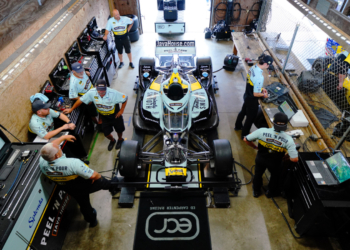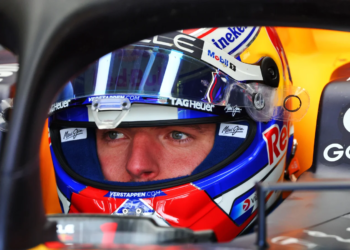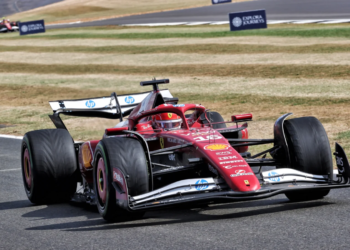Kimi Raikkonen’s victory in Melbourne stunned the paddock but could it be the first of many in 2013?
What was so striking about the win was that it was in conditions that don’t normally suit Lotus. At a race in conditions which are notoriously strong for the team how much quicker could they go? Could they even dominate?
Like last year Lotus are very strong at preserving their tyres. That was already very evident before the F1 circus arrived in Melbourne, with some very strong long runs in winter testing. Not only is their tyre preservation strong but more pace has been added to the mix too.
Melbourne was a cool and wet weekend. Miserable in comparison to past Australian GP weekends.
Last year Lotus weren’t as strong in cool conditions. It wasn’t that they were poor, but they weren’t genuine contenders for victory in that kind of climate.
It was in hot conditions where the E20 was a real factor. If you look at the races where Lotus was in contention the weather was the common link.
Raikkonen almost won in Bahrain, Hungary and Valencia. He then went on to win the Abu Dhabi GP. At all those races warm track temperatures were a feature of the weekend.
It was also warm races where we saw the best qualifying performances from the E20. In the boiling hot temperatures in Hungary Grosjean put his car on the front row. In similar conditions in Valencia both Lotuses started in the top five. On a warm qualifying day at Barcelona both cars again qualified in the top five.
The E21 is an evolution of last year’s E20. Therefore if the warm weather strength has been retained then Lotus could be mighty at a lot of races this year. As the new car isn’t that much different to last year, there is a very strong chance that the E21 has kept that trump card.
It’s nearly impossible to design a car that works just as well in cool conditions as it does in warm conditions. You simply can’t have everything.
Therefore if Kimi could win a race comfortably from seventh on the grid in Melbourne in cool conditions, then it’s feasible that Lotus could be even more formidable in hot conditions. We will find out this weekend in Sepang, which is notorious for being one of the hottest races on the F1 calendar.
Eric Boullier said: “We have some developments coming which is good news, and the hot temperature should normally help us do an even better job.”
It will also be interesting to see how the E21 performs in qualifying. We didn’t really get to see that last weekend as Raikkonen only had one flying lap on dry tyres in which he made a mistake.
He said: “We had just one lap on the dry tyres and I got a bit sideways at the end on a damp patch which meant I lost some time so that was a bit disappointing. The car seems to be working well. It had the speed, but when you have only one lap on dry tyres on a damp circuit setting a fast lap is not the easiest thing to do.”
On paper Lotus ought to go much better over a single lap this year. The problem last year was that the E20 was so easy on its tyres, that it was difficult to get them up to temperature for that all important qualifying lap.
This was why the car qualified better on hot days or on tracks with fast corners, which put more energy in the tyres.
This season all the Pirelli tyres are softer than they were last year. Theoretically that means it should be easier to get heat into them. This means that there is a better chance that a car that is kind to its tyres can also perform well over a single lap.
If Lotus has indeed managed to add more one lap pace alongside their strong race pace, then again this is going to make them much more formidable.
If they can win from seventh on the grid like they did in Melbourne, then they will be in great shape if they qualify closer to the front.
Furthermore you now have Raikkonen in incredible form. As this is the second season of his comeback he doesn’t have any re-adapting to do or rust to shake off, after his adventure in rallying.
He already showed last year how consistent he was, and that he hardly makes any mistakes. These are assets you need in a championship fight.
Also not only does he possess the speed he had when he was at McLaren, but he seems to be the happiest he has ever been in F1. The team understand him and let him be himself. A fast and happy Kimi is one of F1’s most lethal combinations.
He was quick but not always happy at McLaren, and at Ferrari he was often neither.
Boullier says: “I don’t think there is anybody on earth who can tell Kimi what he should do, so I am not going to start.”
He added: “It is true that the environment we have at Enstone is that we want the people to be creative and be themselves. It is much better for them, and we are doing this by limiting the politics and in Kimi by limiting what he hates.”
The perceived problem for Lotus is that they may not be able to keep up with their rivals in the development race. However history doesn’t prove that theory.
Kimi says: “There was a big question mark last year over whether our team could keep up with the development of the bigger teams and I don’t think we did a bad job. Of course it’s not going to be easy for us.”
He added: “I’m sure we have the people and all the tools to make it happen. Budget is always a factor and it’s no secret that we don’t have the same money as Ferrari, Red Bull or Mercedes. If we did have more sponsors I’m sure we’d have a better chance in the battle against those teams.”
In 2010 they were bolting upgrades to the car all season, and genuinely kept up with the development pace of the top teams. In 2008 (as Renault) the team came from quite a long way
off the pace to win two races in the final third of the season (albeit that included the controversial Singapore GP win, which led to crashgate).
Last year they were still adding upgrades to the car in the latter stages of the season. The only reason they suffered a little bit was because they focussed too much time trying to develop passive DRS, which was never actually used last year.
However that work they did on the system could still prove very fruitful for them during 2013.
Many also point to 2011 as evidence Lotus is slow with development. However the reason was they went down a development blind alley with their innovative front facing exhausts. This worked well for them at first but was limiting in terms of further development. It’s similar to Mercedes’ situation with double DRS last year which also limited their development potential.
For the constructor’s championship Romain Grosjean needs to be scoring big points. Tenth place was a poor start for him. This will be a concern for Lotus however we shouldn’t be too quick to judge after just one race.
It wasn’t until later in the weekend that he got the new upgrades for the car that Kimi was also testing on Friday. As free practice on Saturday was wet he didn’t get the chance to test them in the dry and perfect his race setup.
A wrong strategy in the race limited him too. A poor grid getaway didn’t help either. He did qualify that behind Kimi on the grid though at least. Pressure is certainly on him to perform though so we will see how he copes with that.
The key to whether 2013 potentially becomes a Lotus season is how Red Bull fares in Malaysia. Was their average race pace a true reflection of their form, or were they right in that the cool conditions and tyres hampered them?
If Kimi wins again in Sepang, a track that can be a more realistic assessment of the F1 pecking order, then 2013 could well be his year.






